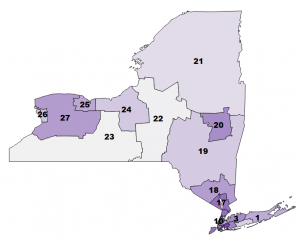Redistricting Threats to New York’s Hispanic Congressional Representation

Sections
Introduction
County-Level Changes
Congressional District-Level Changes
The Independent Redistricting Commission Plans
Appendices
Notes
Notes
i With the research assistance of Damayra Figueroa-Lazu and Jorge Soldevila-Irizarry.
ii https://www2.census.gov/programs-surveys/decennial/2020/data/apportionment/apportionment-2020-table01.pdf (downloaded on May 24, 2021).
iii Article I, section 2 of the United States Constitution states: “Representatives and direct taxes shall be apportioned among the several states which may be
included within this union, according to their respective numbers, ….”
iv Section 2 of the Fourteenth amendment states: “Representatives shall be apportioned among the several states according to their respective numbers,
counting the whole number of persons in each State, excluding Indians not taxed.”
v For apportionment purposes, the Census Bureau uses a state’s apportionment population to determine the number of representatives that will represent it in
the U.S. House of Representatives. The apportionment population is made up of the state’s resident population—the people who resided in the state on census
day 2020—and its overseas population. The overseas population is the segment of the population that may be abroad in the diplomatic service, the armed
forces, or for other reasons, but claim a particular state as their state of residence. For 2020, New York’s apportionment population was 20,215,751 persons. Its
resident population was 20,201,249 persons. Its overseas population was 14,502 persons. https://www2.census.gov/programs-surveys/decennial/2020/data/
apportionment/apportionment-2020-tableA.pdf
vi https://www.census.gov/data/tables/2020/dec/2020-apportionment-data.html
vii https://www2.census.gov/programs-surveys/decennial/2020/data/apportionment/apportionment-2020-tableB.pdf
viii From a numerical perspective, districts with fewer residents are thought of as having greater political power, as it takes fewer voters to elect a representative
that has the same voting power in the legislature as residents of districts with more residents. Districts in highly dense urban areas tend to have more resi-
dents within their districts than less dense rural districts, indicating an imbalance in political power. However, adherence to the one-person, one-vote principle
[Reynold v. Sims (1964); Baker v. Carr (1962)] prevent deviation from numerical equality in population for congressional districts [Wesberry v. Sanders (1964)].
ix Districts 1, 2, 3, 4, 5, 6, 7, 8, 9, 10, 11, 12, 13, 14, 15, 16, 17, 18, 20, 25, 26, and 27.
x Districts 19, 21, 22, 23, and 24.
xi https://nyirc.gov/draft-plans, downloaded on September 24, 2021.
xii https://nyirc.gov/faqs, downloaded on September 24, 2021.